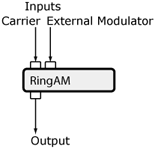| AudioMulch Help > Contraption Reference > Effects | Previous Next |
RingAM
Adds shifted frequencies, and can produce metallic sounds (ring and amplitude modulation).

RingAM applies the process of ring modulation or amplitude modulation to an input. RingAM multiplies the input with either an internal sine wave oscillator or an external input. The resulting sound is usually an inharmonic spectrum, which includes the sum and difference frequencies between the input and the oscillator frequency (or frequencies present in the external modulator). You can adjust the frequency of the internal modulator and select between two different modulation modes. For more information about the differences between amplitude modulation and ring modulation, see the Technical Discussion section below.
 |
See the Adjusting Contraption Properties section for information about using sliders, knobs, presets etc. |
Related Contraptions
Parameters

|
Frequency (ShiftFrequency) |
Controls the frequency of the modulator, with a range of 20Hz - 1500Hz. |
|
Ring Mod |
Selects ring modulation. |
|
Amp. Mod (AM) |
Selects amplitude modulation. |
Instructions
When you attach an external modulator at the second input, the internal sinusoidal modulator is disabled, and the Amp. Mod and Ring Mod settings have no effect.
Relevant Example Files
The following files provide examples of how RingAM can be used:
Elementals.amh, GranPrix.amh, GrungeDrumOne.amh, NoiseResearch01.amh, RingModBassline.amh & TheBells.amh
 |
To open the Example Files directory, go to the File menu, select Open, and double-click on the Examples folder. Read descriptions of the example files here. |
Technical Discussion
RingAM is based on the processes of ring modulation and amplitude modulation. In these processes, an input (carrier input signal) is combined with either an internal sinusoidal modulator, or a second input serving as a modulator. The two signals are multiplied to produce a single output, which consists of both the sum of and difference between the frequencies in the carrier and modulator. These new sum and difference frequencies are called sidebands, the upper sideband relating to the sum of the frequencies, and the lower relating to their difference.
RingAM lets you use three different versions of this process: amplitude modulation (Amp. Mod), ring modulation (Ring Mod), and external modulation. To use external modulation, connect an external modulator at the second input. Amp. Mod and Ring Mod use an internal sinusoidal modulator and external modulation uses full cycle (AC) ring modulation.
Both Amp. Mod and Ring Mod use an internal sinusoidal modulator. Amp Mod multiplies the input signal by a positive sinusoid ranging in amplitude from 0.0 to 1.0, while Ring Mod uses an AC sinusoid ranging from -1.0 to 1.0.
| Previous Next |
